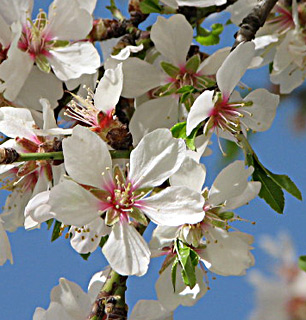Amygdalus korschinskii is a deciduous shrub or tree that grows wild in Israel. It resembles Amygdalus communis (common almond), but differs from it mainly in its leaves and its fruit. The leaf is simple. The blade is approximately 2-3 cm long, with a dentate margin. Tiny protrusions sometimes appear on the margin. The petiole is short and has short deciduous stipules. The leaves alternate on the stem. Contrary to other almond species, there are no thorns on the branches of Amygdalus korschinskii.
The bisexual flowers bloom during February and March, usually before sprouting. During the blooming season the tree becomes covered with groups of large white-pink flowers. The flowers are fragrant and draw insects, mainly the honey bee which is one of the plant’s pollinators. The corolla has five petals which can be seen from a distance. The calyx has five lobes and the calyx tube is covered with scales. There are 10-30 separate stamens. The filaments are prominent and full of pollen. The pistil is found between the stamens. It is slightly longer than the stamens, pale white, and the stigma is not very prominent. The lower part of the pistil is the ovary. In the almond, as in other members of the Rosaceae family, the ovary is inferior. However, in this species it has only one carpel.
After pollination, the ovary swells and develops into a fruit, which is a hard drupe enveloped by a pilose green pericarp. Upon ripening the pericarp changes color and is shed, leaving a hard, brown and thick drupe on the branches. The drupe contains only one seed. The seeds of Amygdalus korschinskii are bitter and inedible. The toxicity of almonds is imparted by a material, amygdalin, that contains the toxin cyanide and after which the almond is named. As long as the seed is intact, the amygdalin is preserved in the cells and the poison is inactive. However, if someone tries to eat the seed and crushes the cells, the amygdalin comes into contact with an enzyme that degrades it and releases the cyanide. This mechanism of protection against being eaten is not unique solely to the almond, and exists in other plants as well, where the most famous is the Cassava (Manihot esculenta), also called Tapioca, whose thick roots are used for preparing porridge and drinks.
The habitat of this almond is in the desert borderland, in the Pistacia atlantica (Atlantic Pistacia) and Crataegus aronia (Spiny Hawthorn) plant association and in arid parts of the Mediterranean region on exposed rocks. It is common in the eastern Galilee, the Samaria Desert and the Hula Valley as well as in the Judean Mountains. Its origin is Iran-Turanian.
The tree is protected by law.
Written by Dr. Erga Aloni









